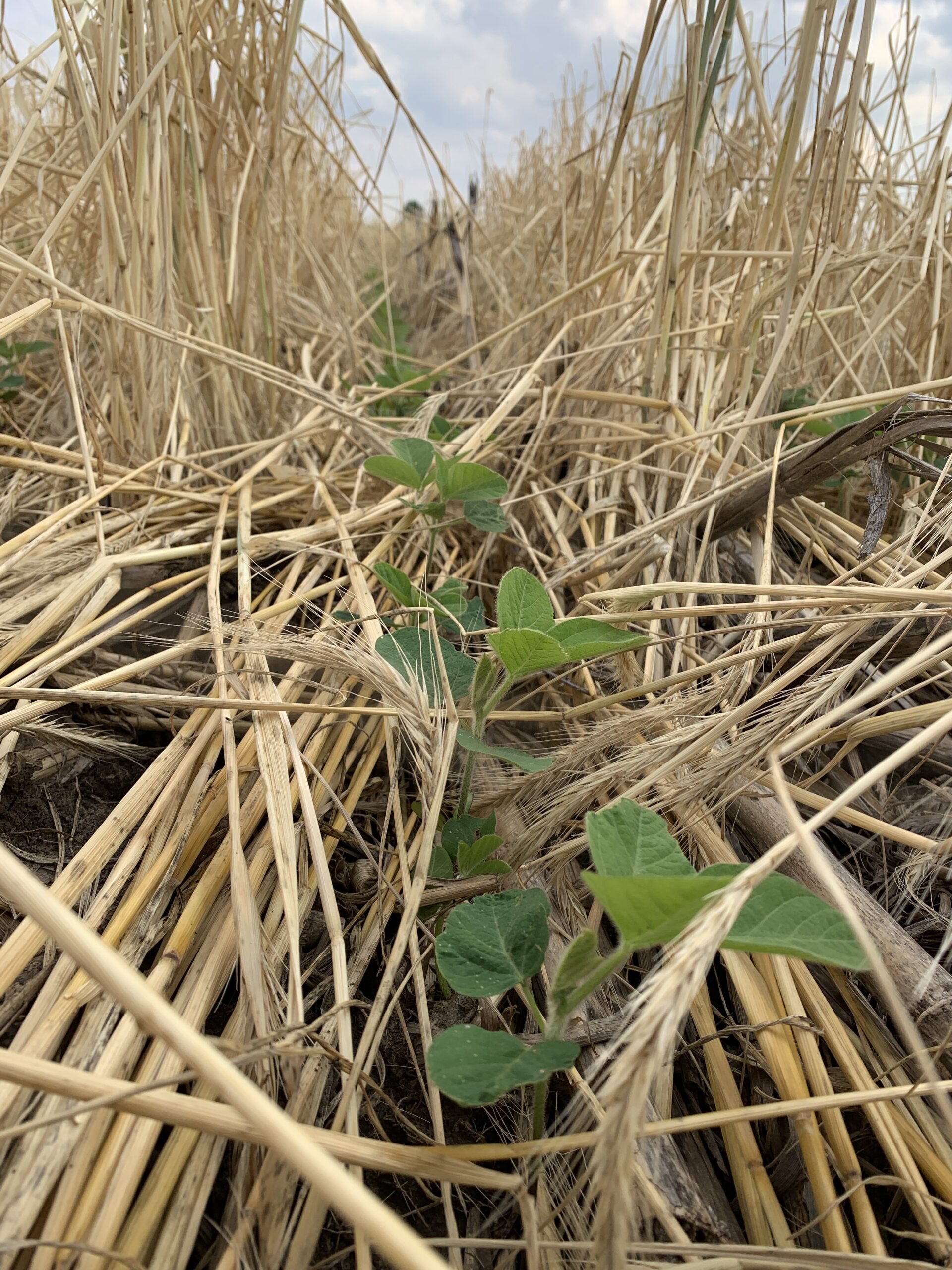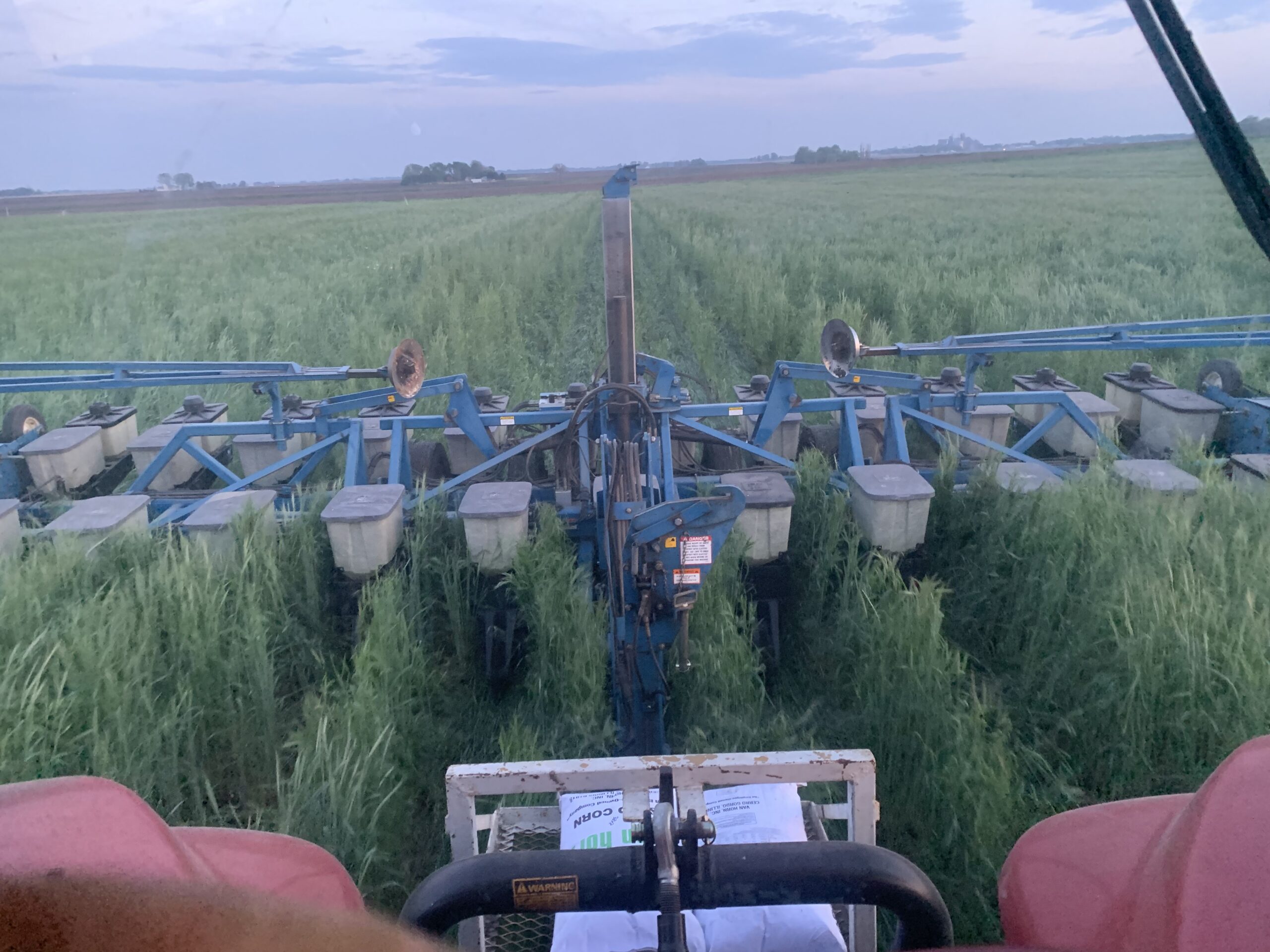I’ve always wanted pictures of a cover crop peeking out from underneath of a light blanket of sparkling white snow. It’s turned into a game of ‘caption this!’ – “cover crop under cover” or something else super cheesy. But really, it’s an instant visual story: a winter scene, a green crop gently flocked with snowflakes, green plants apparent where the wind had whipped the snow and left behind bare spots on the ground. It’s the perfect visual of life that messes with our standard notion of nature being dead and frozen in the winter. 
A few weeks ago, I was on my way home from my annual meeting with the banker to go over the previous year’s balance sheet and this coming year’s crop plan and stumbled across the perfect opportunity to finally get this photo. Early winter sunsets in combination with my 9-to-5 job makes it a little difficult to get out to the field while it’s still light out, but I hit the trifecta on this day: daylight, a light snow that had started melting off, and a cover crop that was tall enough to actually look like a cover crop.
This particular cover crop was planted during the last week of October 2020. Our farm has come a long way since the very first cover crop we planted about five years ago. But before that was when my dad and my uncle (the two primary operators on our 500-acre farm) started to experiment with different techniques that radically changed the way they farmed. Ever since my grandpa retired and they began farming together in 1999, they’ve been toying with different practices. First, it was reducing tillage. Then it was no-till. Then it was some tillage plus cover crops. I remember the first cover crops seeded were a mix of tillage radishes and cereal rye (I totally dug up one of the tillage radishes for an Instagram photo…don’t tell Dad). The next year, it was crimson clover. They quickly figured out cereal rye was a great option for our fields – it’s relatively inexpensive, it germinates quickly in the fall, and it turns out it’s really nice to plant soybeans into the following spring. Of course, there’s been challenges along the way, like a wet spring in 2019 that kept us out of the field but created the perfect conditions for the cereal rye to take off like crazy. That was the year we planted soybeans into a six-foot-tall sea of green, which actually worked out really well except for having to clean long stems of rye out from the closing wheels on the planter every couple of rounds. But you learn from your experiences, right?
That’s where the cover-crop-in-snow photo was taken. My dad announced plans last summer that he wanted to adapt the planter to be able to plant our own cereal rye in the fall, immediately after harvest. Previously, we would have someone either fly the cover crop seed over the standing corn field a few weeks before harvest or they would mix it in with a little potash and spread it over the field soon after the field had been harvested.

I’m sure neighbors will recall 2020 as the year we went crazy. I planted my very first corn crop on my own slice of rich, black central Illinois soil last spring, so keep in mind that this also marked the year that I started farming. (Coincidence?)
2020 was the first year we planted cover crops on every (next year’s) soybean field. I have a great photo of the combine harvesting corn in the back of my grandma’s field and the planter planting cereal rye in the foreground, which is not something you typically see in central Illinois in late October. We didn’t stop there. Literally overnight, all of our 2021 corn fields were strip tilled, with one trial corn field planted to cereal rye and strip tilled in offset rows.
As you can probably tell from this story, my family is a classic case of on-farm experimentation. Most farmers participate in this to some degree. We just happen to be fascinated with plants that grow in the winter and take off in the spring before planting, making us look a little crazy. Over time, my dad and uncle have figured out what works for each field ahead of each crop, moving our farm to very little tillage today. Now that the farm-wide soybean cover crop strategy is underway, I would suspect that we consider expanding the strip-till-plus-cover-crop-ahead-of-corn strategy for the 2022 crop year provided that all goes well with the single-field experiment this year. Planting cereal rye with the planter seemed to work out well this year, so I expect that to continue, as well. Future experiments will likely include things related to nutrient management, probably tweaking application rates in accordance with University of Illinois guidelines and our field story as told by soil samples, and possibly adding another variety to the cover crop mix.
Ultimately, I feel that our farm is on the right track for what is being asked of farmers in the face of changes we’re seeing in our global climate. Cover crops and reduced tillage are thought to be great opportunities to sequester carbon. And then there’s the long-term desire to be more conscientious of nutrient management on farms – that’s really what got us interested with cover crops to begin with. But what drives us is the results we’re seeing that positively impact our productivity. Cover crops have helped us with weed suppression – in fact, we still have residue from when the cereal rye got so tall in spring 2019. We think that cover crops help hold on to nutrients, like nitrogen, over the winter, making it easily available to the new crop in the spring. We feel that the cereal rye helps with water infiltration, making it possible to plant fields a little sooner during wet springs.

They say you only get 40 harvests in your career, so I look forward to seeing how my first year of farming compares to the practices used in my 40th.




 and then
and then